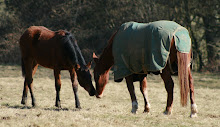In answer to Jeni's question, the general rule of thumb for a mare's gestation is 11 months and one week after her covering date. However there are various things that come in to play, such as time of year, weather etc so it can vary quite widely, sometimes between a fortnight. She needs a close eye kept on her about a month prior to her foaling date in order to check for any changes.
One of the most obvious signs is her 'bagging up' which is when her udder starts to fill up. This should start changing at least a month - two moths before foaling. However with maiden mares such as Penny (first time mum's) the changes aren't always so obvious. Immediately prior to foaling she will start 'waxing up' which is when you will find a milky wax on her teats. She may even run milk. If she does run milk for long then we need to collect it, as it contains the vital colostrum for the foal, which it needs in it's first few hours of life, giving it the immunisation provided by the mare.
Monday, 27 November 2006
Thursday, 23 November 2006
Wednesday, 22 November 2006
Penny is due to have her first of three Equine Herpes Virus (EHV) vaccinations on 5th December.
Here is a bit about it: Equine Herpes Virus or Equine Rhinopneumonitis virus orEHV is a highly infectious viral disease. EHV-1 can cause abortion, respiratory disease and paralysis. EHV-4 can also cause abortion but usually causes only respiratory disease. The virus can survive for 14 - 45 days in the environment and is spread via the respiratory tract or from aborted fetuses, membranes and fluid. Infected foals can also pass the infection onto healthy mares in their group via their respiratory systems. Once a pregnant mare is infected she may abort from 4 months onwards but it is usually between the 8th and 11th months. ABORTION may take place several months after infection or as little as 2 weeks later. Content from petcaretips.net
Here is a bit about it: Equine Herpes Virus or Equine Rhinopneumonitis virus orEHV is a highly infectious viral disease. EHV-1 can cause abortion, respiratory disease and paralysis. EHV-4 can also cause abortion but usually causes only respiratory disease. The virus can survive for 14 - 45 days in the environment and is spread via the respiratory tract or from aborted fetuses, membranes and fluid. Infected foals can also pass the infection onto healthy mares in their group via their respiratory systems. Once a pregnant mare is infected she may abort from 4 months onwards but it is usually between the 8th and 11th months. ABORTION may take place several months after infection or as little as 2 weeks later. Content from petcaretips.net
Subscribe to:
Comments (Atom)





















































